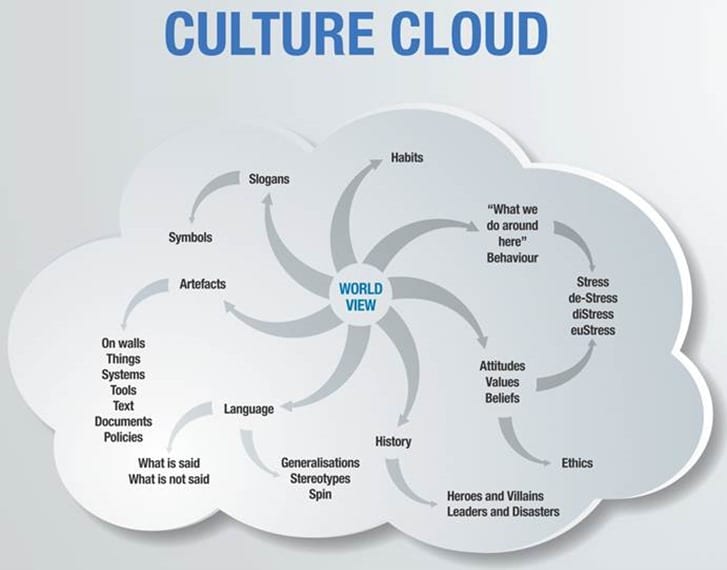Safety Under Stress
 Stress is a part of living, the pressure of being a fallible being in a complex world is stressful, but is stress bad? In what ways are humans stressed and how does this affect the discerning of risk and safety?
Stress is a part of living, the pressure of being a fallible being in a complex world is stressful, but is stress bad? In what ways are humans stressed and how does this affect the discerning of risk and safety?
There are four kinds of stress and each affects humans socially, psychologically, physiologically and culturally, these for kinds of stress are: stress, distress, eustress and de-stress. These are mapped on the Human Dymensions Culture Cloud that indicate that ‘what we do around here’ is an inadequate definition of culture. The Culture Cloud map is attached to show how culture is like an observable but untouchable cloud.
The naïve behaviourist view that observation is both neutral and objective falls over when one considers how various forms of stress affect behaviour. Without relationship, community, trust and reciprocal understanding most observations are the selective attributions of the observer projected onto the situation. Without conversations (in relationship) about perception and motivation in a climate of trust, most observations are subjective speculation. This is the problem with most incident investigations, the assumption that the observer is objective is nonsense. Most of the incident investigations methodologies do not address this issue but in typical safety tradition take an engineering and objects approach to activity. Most incident investigations methodologies rarely tackle the issue of observer subjectivity. In the Human Dymensions SEEK program we tackle this issue head on in a socialpsychological approach to incident investigation. But let’s get on and discuss stress.
Stress is not bad but a necessary part of facing life’s challenges. Whilst the dreamers maintain the delusion that ‘all accidents are preventable’ the rest of us know that the bumps and challenges of life are necessary for learning, resilience and maturation. There can be no resilience without stress, and no learning without risk.
Stress is pressure; we need timelines, checklists, expectations and goals to live. When these goals and expectations are perfectionist and absolute then we move into a form of stress that is unmanageable – distress. Manageable stress enhances well-being and develops resilience. Resilience is the adaptable toolbox that helps us not be crushed by the challenges of life. When humans can’t cope with distress they become unwell and often only medicated intervention can help.
Distress is when stress pressure becomes too much, when things are unattainable and unachievable. Distress often causes great anxiety and depression, this is why perfectionism (and absolutes) is categorized as a mental health disorder. CEOs who espouse the nonsense language of goal perfectionism create distress in their organization and foster organizational mental health problems. Every time a calculative organization displays the number of times they don’t achieve their absolute goal, the by-product is psychological distress. The continued paradigm of deficit thinking in safety, of trying to establish safety by counting the absence of errors, creates safety distress. The resultant ‘game playing’, under reporting, data counting, injury reclassification and reframing of problems are symptoms of that safety mental health disorder.
The next form of stress is eustress, this is euphoric stress, when people get excited and ‘pumped up’ by stress. I have been in crises and seen the destructiveness of this form of stress. People running around the control room excited by phenomenal complex challenges whilst members of their team are dysfunctional and overcome by the seemingly intractability of the same problem. The mismatch of stress and stressors in teams and organisations is often the cause of conflict and strategy mismatch.
The fourth form of stress is de-stress, this is the state of under utilized stress, when we are perhaps too relaxed, too ‘out of it’ to respond. We might feel like this on holiday but it can be a problem in the workplace. Sometimes we can be so comfortable, habituated and desensitized in our work that our de-stress becomes complacency. Complacency is also a form of automaticity and why safety people should be more educated about homeostasis, desensitisation and repetition.
So it could be that one’s observations are of an aberration of behaviour, one’s misunderstanding of distress could drive decisions about safety and risk that are a mismatch. Without observation and conversation under the dynamic of relational reciprocation, safety will imagine that observation is about objects, neutrality and the mechanics of behaviour.




Do you have any thoughts? Please share them below